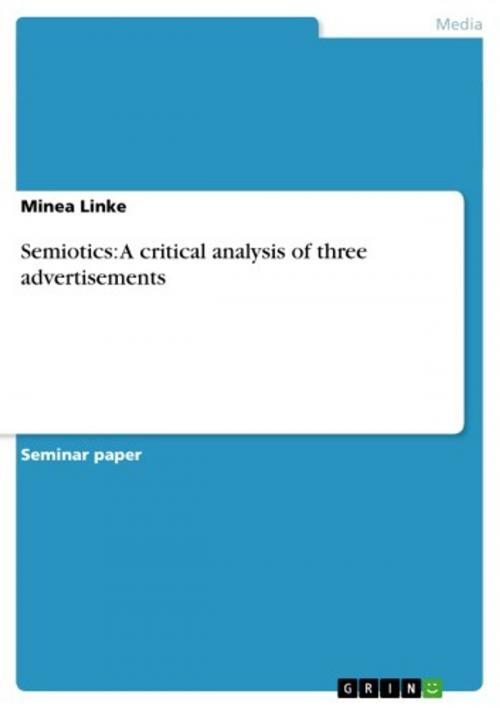| Author: | Minea Linke | ISBN: | 9783638257138 |
| Publisher: | GRIN Publishing | Publication: | February 26, 2004 |
| Imprint: | GRIN Publishing | Language: | English |
| Author: | Minea Linke |
| ISBN: | 9783638257138 |
| Publisher: | GRIN Publishing |
| Publication: | February 26, 2004 |
| Imprint: | GRIN Publishing |
| Language: | English |
Seminar paper from the year 2004 in the subject Communications - Public Relations, Advertising, Marketing, Social Media, grade: second upper degree, University of Lincoln (-), 12 entries in the bibliography, language: English, abstract: Semiotics is often easily described as the study of signs, though this definition does not foreshadow the dimension of this topic. The reason for this is that the term 'sign' is a concept of broad comprehension; a sign is a meaningful unit, which is interpreted as 'standing for' something other than itself. Signs are found in the physical form of words, images, sounds, acts or objects (...) they have no intrinsic meaning and become signs only when sign-users invest them with meaning with reference to a recognized code (Chandler, 2002, p.241). The definition of a sign as a 'thing-plus-meaning' was given by J. Williamson (Williamson, 2002, p.17). The meaning, which is made out of signs, is of great importance for us, because it is a means to structure our life, thus the study of signs is important within advertising that is a part of our daily life. The task of this paper is to show how signs create meaning by analysing three different advertisements for small cars of different brands. With the help of semiotics, but also by the consideration of the external environment of the advertisement, their messages should be identified. In the first chapter the model of the Swiss linguist Ferdinand de Saussure is discussed. The second chapter includes the model of the American philosopher Charles Sanders Peirce and in the third chapter the models of Roland Bathes and Erwin Panofsky are demonstrated. Starting from these models the different advertisements are discussed in chapter four to seven. Each advertisement is classified by one of the models mentioned above. The additional investigation of the target audience and the external environment will justify the different messages. The conclusion in chapter eight represents a résumé of the role of semiotics within advertising.
Seminar paper from the year 2004 in the subject Communications - Public Relations, Advertising, Marketing, Social Media, grade: second upper degree, University of Lincoln (-), 12 entries in the bibliography, language: English, abstract: Semiotics is often easily described as the study of signs, though this definition does not foreshadow the dimension of this topic. The reason for this is that the term 'sign' is a concept of broad comprehension; a sign is a meaningful unit, which is interpreted as 'standing for' something other than itself. Signs are found in the physical form of words, images, sounds, acts or objects (...) they have no intrinsic meaning and become signs only when sign-users invest them with meaning with reference to a recognized code (Chandler, 2002, p.241). The definition of a sign as a 'thing-plus-meaning' was given by J. Williamson (Williamson, 2002, p.17). The meaning, which is made out of signs, is of great importance for us, because it is a means to structure our life, thus the study of signs is important within advertising that is a part of our daily life. The task of this paper is to show how signs create meaning by analysing three different advertisements for small cars of different brands. With the help of semiotics, but also by the consideration of the external environment of the advertisement, their messages should be identified. In the first chapter the model of the Swiss linguist Ferdinand de Saussure is discussed. The second chapter includes the model of the American philosopher Charles Sanders Peirce and in the third chapter the models of Roland Bathes and Erwin Panofsky are demonstrated. Starting from these models the different advertisements are discussed in chapter four to seven. Each advertisement is classified by one of the models mentioned above. The additional investigation of the target audience and the external environment will justify the different messages. The conclusion in chapter eight represents a résumé of the role of semiotics within advertising.















